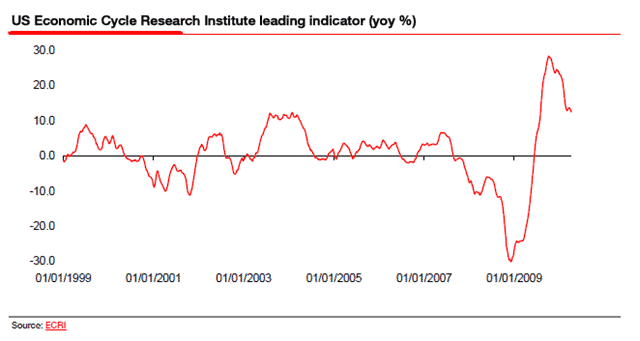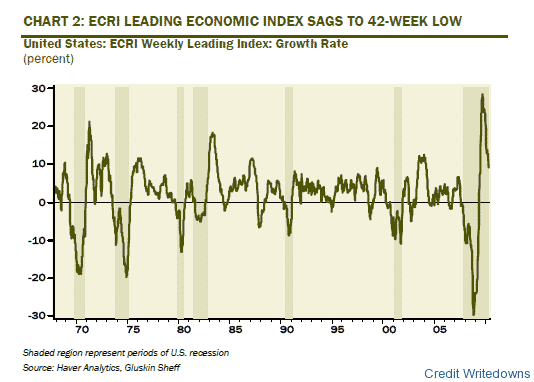ECRI Leading Economic Index at 42-week Low; Recovery is already fading
A month ago I showed you a bunch of charts which indicated that the US economy was slowing. The upshot of the charts was that the economy was going to stall in six to nine months and that stock prices would reflect this – and they have.
Amongst the charts was the change in the ECRI Leading Economic Indicator. Here’s what Albert Edwards had to say about the data. Take a look.
I have had a few e-mails recently about some of the key leading indicators reaching new cyclical highs last week, and what this means for our view. To be sure, the latest weekly reading for the Economic Cycle Research Institute (ECRI) key lead indicator reached a 99 week high. That, at first sight, looks very bullish for the continuation of this cyclical upturn. However, as with all of these lead indicators, it is the rate of change that is important. The ECRI also report a smoothed annual change in their index. Last week that slipped to +12.5% yoy, which is a 37-week low (see chart below). Now one doesn’t want to be too armageddonish at this stage, but this is clear evidence that in 6-9 months time there will be a discernible slowdown in the economic recovery from its recent moderate pace.
Not good. So clearly we want things to turn around in a hurry. But that’s not happening, as David Rosenberg points out in his typically bearish Breakfast with Dave missive today. Rosenberg says:
The downdraft in the market in recent weeks reflects the financial risk related to the European debt crisis, the monetary tightening in China and the re-regulation of the financial sector that is currently making its way through to Congress. The next leg down in the equity market specifically and cyclical assets more generally is economic risk. Equities went into this period of turbulence priced for peak earnings in 2011 and with a tailwind of positive earnings revision and positive guidance ratios from the corporate sector. If the ECRI and the Conference Board’s own index of leading economic indicators, which dipped 0.1% in April, are prescient, then they are portending a period of sub-par economic growth ahead (the ECRI is pointing to 1½% real GDP growth in the second half of this year). As the events of 2002 showed, more-than-fully valued markets do not need a double-dip scenario to falter — a growth relapse can easily do the trick. It’s still time to be defensive and too early in this correction to be picking the bottom.
This is the exact same chart Edwards showed us a month ago and it is much worse today than it was then. What does that tell you? Remember all the happy talk and propaganda coming out of the Obama Administration about how they saved the banks and saved the economy last month? No one’s talking about that any more. I reckon people realize that they were getting ahead of themselves – with Europe imploding and all. Instead, now the Obama Administration is floating the idea of a $200 billion mini-stimulus package to buoy the economy ahead of the mid-term elections. And Geithner is talking up sham stress tests for Europe – just like the ones the US had. And look what it has done for American banks. All of this is being done without admitting the stimulus is wearing off.
No matter. We all know the conditions on the ground are not looking good. And David Rosenberg has put out a list of ten reasons the leading indicators are rolling over to prove it.
- The ECR weekly leading index growth rate peaked on October 9, 2009 (at 28.54%; now at 9.0%).
- The Conference Board’s LEI peaked at 109.4 in March (109.3 in April).
- ISM orders/inventory ratio peaked at 1.805 in August 2009 (1.33 in April).
- University of Michigan consumer expectations peaked on September 2009 (at 73.5) – now at 65.3 in May.
- The UofM index of big-ticket consumer purchases peaked in February-March at 136; is down to 129 as of May.
- Jobless claims bottomed at 442k on March 11. They had peaked at 651k on March 28, 2009. But they are back at 471k, which is where they were back on December 19, 2009 so the improvement has stalled out. Not only that, but to keep 472k into perspective, claims were at 453k the week after 9/11 (and the economy back then was eight months into recession). Yes, yes, employment has been rising of late; however, keep in mind that nonfarm payrolls are in the index of coincident indicators; claims are in the index of leading indicators. Please let’s not drive looking through the rear window.
- Single-family building permits peaked at 542k (annual rate) in March (were 484k in April).
- Mortgage purchase applications peaked on April 30th at 291.3 and now are at a 13-year low of 192.1 even though mortgage rates have come down 20 basis points since the nearby high.
- Auto production peaked at 7.8 million units (seasonally adjusted annual rate) in January – was at 7.2 million in April.
- Electrical utility output was down 0.1% YoY as of May 15th. Could be another early sign that the production revival is behind us.
I seriously doubt we are going to see any real stimulus here. My recovery within a depression scenario seems like what’s happening.


Two things I note, one is that the recession shading has mysteriously swept past June 31, 2009, the shading I remember from the last ECRI chart I saw. And two, that the leading indicators were still in positive territory at the outset of 2008. Have they been fiddling with the components? In any event, even these charts show that “leading” is not very apt. They are (or were) heavily weighted toward financial market measures, and are more coincident. If they lead, it is not by very much.
The shading may be Rosenberg’s so I wouldn’t read anything into the chart. Another point, you are looking at the growth in the LEI as opposed to the raw data. Also note that Lakshman Achuthan of ECRI was extremely bullish in 2009 – almost too bullish in my view.And these ARE leading indicators. They consistently turn down before the economy, especially when looking at the first derivatives as we see here. You may be objecting to David Rosenberg’s list of ten. But those are different.